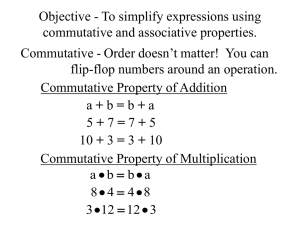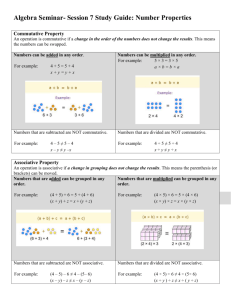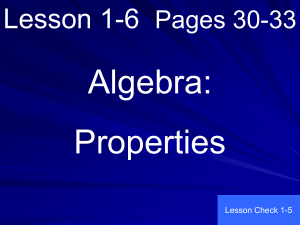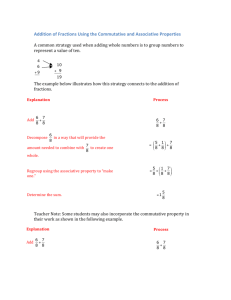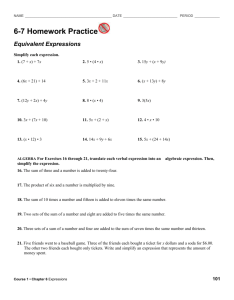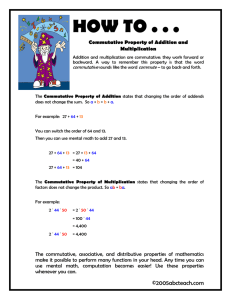Lesson 1-4 - Math Slide Show
advertisement
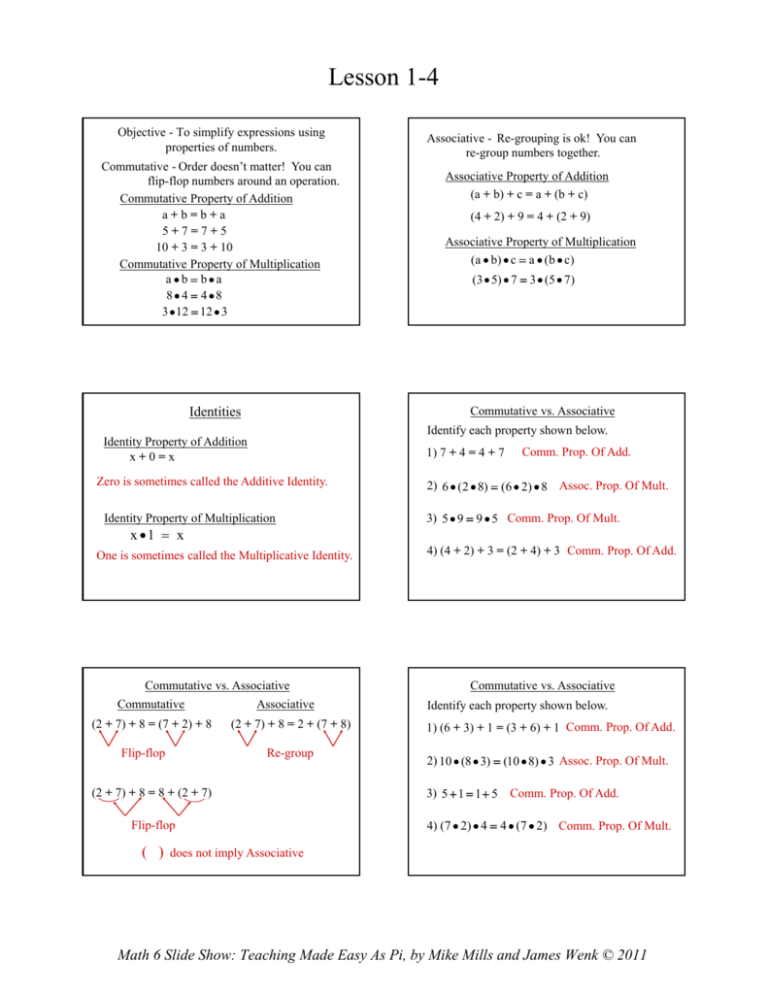
Lesson 1-4 Objective - To simplify expressions using properties of numbers. Commutative - Order doesn’t matter! You can flip-flop numbers around an operation. Commutative Property of Addition a+b=b+a 5+7=7+5 10 + 3 = 3 + 10 Commutative Property of Multiplication a •b = b•a 8• 4 = 4•8 3 • 12 = 12 • 3 Associative - Re-grouping is ok! You can re-group numbers together. Associative Property of Addition (a + b) + c = a + (b + c) ((4 + 2)) + 9 = 4 + ((2 + 9)) Associative Property of Multiplication (a • b) • c = a • (b • c) (3 • 5) • 7 = 3 • (5 • 7) Commutative vs. Associative Identities Identify each property shown below. Identity Property of Addition x+0=x 1) 7 + 4 = 4 + 7 Zero is sometimes called the Additive Identity. Identity Property of Multiplication x •1 = x One is sometimes called the Multiplicative Identity. Commutative vs. Associative Commutative Associative (2 + 7) + 8 = (7 + 2) + 8 Flip-flop Comm. Prop. Of Add. 2) 6 • (2 • 8) = (6 • 2) • 8 Assoc. Prop. Of Mult. 3) 5 • 9 = 9 • 5 Comm. Prop. Of Mult. 4) (4 + 2) + 3 = (2 + 4) + 3 Comm. Prop. Of Add. Commutative vs. Associative Identify each property shown below. (2 + 7) + 8 = 2 + (7 + 8) 1) (6 + 3) + 1 = (3 + 6) + 1 Comm. Prop. Of Add. Re-group 2) 10 • (8 • 3) = (10 • 8) • 3 Assoc. Prop. Of Mult. (2 + 7) + 8 = 8 + (2 + 7) Flip-flop 3) 5 + 1 = 1 + 5 Comm. Prop. Of Add. 4) (7 • 2) • 4 = 4 • (7 • 2) Comm. Prop. Of Mult. ( ) does not imply Associative Math 6 Slide Show: Teaching Made Easy As Pi, by Mike Mills and James Wenk © 2011 Lesson 1-4 (cont.) Give the property that justifies each step. Identify the property shown below. 1) 6 + 8 = 8 + 6 Comm. Prop. of Add. Statement 16 + (27 + 84) Reasons Given 2) (10 • 4) = (4 • 10) Comm. Prop. of Mult. 16 + (84 + 27) Comm. Prop. of Add. 3) (2 + 10) + 3 = (10 + 2) + 3 Comm. Prop. of Add. (16 + 84) + 27 Assoc. Prop. of Add. Comm Prop Prop. of Mult Mult. 4) 5 • (7 • 4) = (7 • 4) • 5 Comm. (100) + 27 Add 16 and 84 5) 7 • 0 = 0 Mult. Prop. of Zero 127 Add 100 and 27 6) 7 + 0 = 7 Identity Prop. of Add. 7) 7 • 1 = 7 Identity Prop. of Mult. Use the commutative and associative properties to simplify each expression. 1) 25 • (37 • 4) 2) 12 + (29 + 8) 25 • (4 • 37) 12 + (8 + 29) (25 • 4) • 37 (12 + 8) + 29 (100) • 37 (20) + 29 3700 49 Distributive Property a(b + c) = a • b + a • c or a(b − c) = a • b − a • c Order of Operations Distributive Property 3(4 + 5) = 3(9) = 27 3(4) + 3(5) It works! 12 + 15 27 Why use the distributive property? 3(x + 2) = 3(x) + 3(2) = 3x + 6 Use the distributive property to help simplify the following without a calculator. 1) 5(9.96) 2) 7(8.2) 5(10 − 0.04) 7(8 + 0.2) Use the distributive property to help simplify the following without a calculator. 3) 8($11.30) 4) 7 × 5.95 7(6 − 0.05) 8($11 + $0.30) 5(10) − 5(0.04) 7(8) + 7(0.2) 8($11) + 8($0.30) 50 − 0.20 0 20 56 + 1.4 14 $88 + $2.40 $2 40 7(6) − 7(0.05) 42 − 0.35 0 35 49.80 57.4 $90.40 41.65 Math 6 Slide Show: Teaching Made Easy As Pi, by Mike Mills and James Wenk © 2011

